Our friends at Platatac have posted the full version on YouTube of “Battle for the Golden Road” a 1984 documentary on selection for the Australian Special Air Service.
Our friends at Platatac have posted the full version on YouTube of “Battle for the Golden Road” a 1984 documentary on selection for the Australian Special Air Service.
Congress requires the independent assessment of the operational effectiveness, suitability, survivability and — where applicable — lethality of Defense Department weapon and business systems by testing production representative systems, used by regular service members who are trained on the systems before a decision on full-rate production is reached.
This is where the Office of the Director, Operational Test and Evaluation comes in.
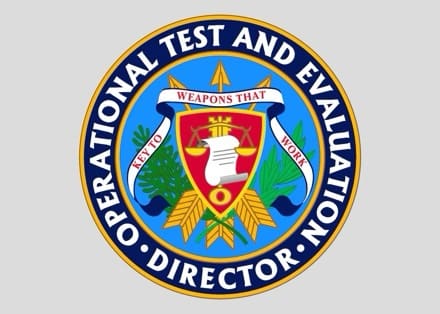
Established by Congress in 1983, the DOT&E serves as the principal official and adviser to the secretary of defense, the undersecretary of defense for acquisition and sustainment, the undersecretary of defense for research and engineering, and the secretaries of the military departments on all matters related to both the operational test and evaluation and live-fire test and evaluation of the services and systems acquired by DOD.
Currently, the DOT&E is independently assessing about 250 systems throughout DOD, with a system being “anything from a business system all the way to space satellites and everything in between,” said Raymond O’Toole Jr., principal deputy director of operational test and evaluation during a recent interview.
The standard routine for evaluating a system begins with a team from DOT&E partnering with the program office responsible for the acquisition of the system. The team then works with the program office, as well as members of the Office of the Undersecretary of Defense for Research and Engineering, which is responsible for developmental testing, to develop a test and evaluation master plan or a test and evaluation strategy if it’s following a pathway other than the major capability acquisition pathway.
During system testing, DOT&E works to get a credible evaluation of each system’s suitability, survivability, operational effectiveness and — when appropriate — lethality with a goal of enabling the delivery and fielding of proven capabilities to warfighters.
One key aspect of DOT&E’s testing process is that weapons systems are tested in realistic combat conditions.
“We’re not restricted or bound by a requirements document with regard to our assessment of the operational effectiveness and suitability of the system,” said Garry Bishop, deputy director of operational test and evaluation for land and expeditionary warfare.
“We look at it from a realistic combat environment [with] realistic combat conditions,” Bishop continued. “A system may not be required to have certain capabilities against certain threats … but we assess that in that operational environment.”
As an example of such testing in the operational environment rather than just testing basic system requirements, O’Toole referenced the Army’s Bradley Fighting Vehicle.
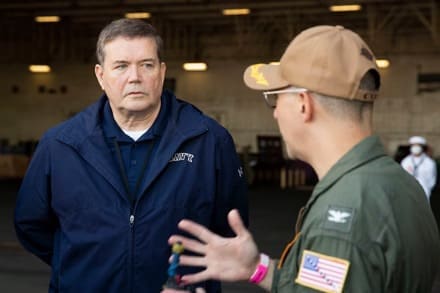
“The Bradley doesn’t go out by itself,” he said. “So, while we do look at the individual Bradley with respect to its survivability against live-fire threats, when we do operational testing, we’re also assessing how it’s used in operations … as a unit of [fighting vehicles] and not just an individual Bradley.”
In addition to the independent assessments that DOT&E conducts, the office also assembles an annual report each fiscal year for Congress and the secretary of defense.
“While we don’t report on all 250 programs, we do report on the programs that have had significant operational and live-fire testing in that fiscal year,” said O’Toole, who holds a doctorate in engineering. He added that the National Defense Authorization Act requires DOD’s service secretaries to document their positions with respect to DOT&E’s report.
Along with testing in realistic combat conditions, another aspect of what makes DOT&E somewhat unique among government organizations is the office’s independence.
“Under Title 10 [of the U.S. Code], that’s what we owe to Congress: our independent assessment, not filtered by the secretary of defense and not filtered by the services, but [rather] it’s our assessment. The director’s assessment is based upon the data that we provide and the operational testing and live-fire testing that was conducted,” Bishop explained.
“So, … an unbiased, unfiltered assessment is what you get from DOT&E,” he said.
Though Congress and the secretary of defense are DOT&E’s primary audience, O’Toole sees the organization as being a service to the front-line men and women in uniform.
“I really believe our customer is the warfighter,” said O’Toole. “Because we are telling the warfighter what the truth is about, what they are getting out in the field.”
To that end, O’Toole said DOT&E has been working for years to see how the organization can speed up the process of gathering data generated in other fields, in hopes of being able to use that data to satisfy some elements of a system’s operational test and evaluation master plan, thus potentially expediting that system’s delivery.
“We are constantly looking at the ability to increase the speed of our assessments as a faster way to support the needs of the warfighter,” O’Toole said.
One way DOT&E is going about that is by working to get away from the linear test model — in which a system has to go through contractor testing and developmental testing before it can get to operational testing — to a more integrated test model.
“We’re trying to get more of our operational insights earlier in the [system’s] development phase where you can actually affect changes to the design, if needed, and get some insight that determines the scale and scoping of operational testing as you progress through the life cycle of the program,” Bishop said.
As one example of that, Bishop referenced a recently completed test of the Army’s terrestrial layer system, which is designed to deliver integrated cyber and electronic warfare capabilities to soldiers on the battlefield.
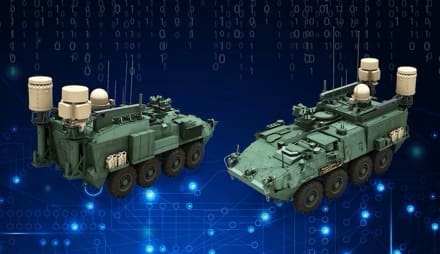
Bishop said that DOT&E was involved from the very early stages of that system’s development, which allowed DOT&E to explain to the system developer what the team was looking for in operational testing. As a result, the developer was able to adjust some of the system’s testing mechanisms to account for how the soldiers were actually using the system out in the field.
“Testing doesn’t cause delays; the results of testing cause delays if deficiencies are found and the developer chooses to correct them,” said Bishop. “So, the job of testers — both developmental and operational — is to inform the developer. The earlier they can find those deficiencies and vulnerabilities, the earlier the opportunity to fix the system, so that when it’s filtered to our warfighters, they get a credible system.”
In addition to test and evaluation within the Defense Department, DOT&E also is responsible for the International Test and Evaluation Program. According to DOT&E literature on the program, the ITEP “permits establishment of bilateral and multilateral agreements between the United States and international partners.”
“We are unique,” O’Toole said. “There is no other organization like DOT&E, in the world that provides independent assessment.”
Being responsible for international test and evaluation sometimes affords DOT&E leadership the opportunity to interact with members of international defense communities. One example is when O’Toole recently held a briefing at the International Armoured Vehicles Conference in London in January.
“During the briefing, the room was very focused, and it’s not because I was the guy standing up there; it’s because of the message I was delivering,” O’Toole said. “And that message was [that] we provide credible assessment, and we’re not afraid to go and say where things are wrong, how to go fix it, and then retest it. We also say what is right or working as intended.”
Moving forward, O’Toole said that DOT&E will be focusing not just on testing individual systems, but families of interconnected systems.
“And we’re looking at that not just from a testing standpoint, but from a training standpoint,” he added.
As an example of that, O’Toole mentioned the Joint Simulation Environment that is used to train pilots of the F-35 Lightning II — the DOD’s premiere, multirole combat aircraft.
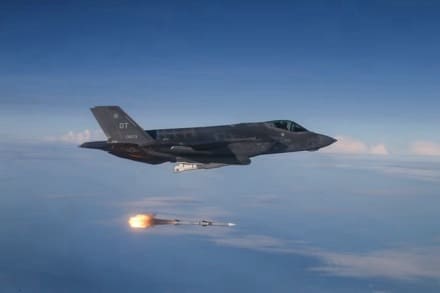
“People are saying to me … that they’ve gotten more out of sitting in a JSE cockpit than they ever got when they were on the range and out in the open air because of the threats and capabilities that they were able to actually utilize,” he said, referring to the fact that safety and environmental restrictions on ranges sometimes preclude the testing of certain capabilities and threats.
O’Toole also said DOT&E is getting more involved with the world of artificial intelligence.
“We’re very involved with the industry, and the best and the brightest [individuals] on how to utilize and test artificial intelligence,” O’Toole said, adding that DOT&E is fully engaged with DOD’s Chief Digital and Artificial Intelligence Office.
“We’re thinking ahead, and that’s where we’re going; that’s where we want to be going; and that’s where we need to go for the future.”
By Matthew Olay, DOD News
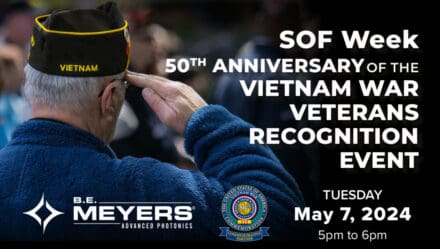
26 April 2024 (Redmond, WA) – B.E. Meyers & Company, Inc., a US defense technology manufacturer in its 50th year, is proud to partner with the US Vietnam War Commemorative Office as a Commemorative Partner.
On Tuesday, 07 May 2024 from 5pm to 6pm, B.E. Meyers & Co. will host the SOF Week 50th Anniversary Recognition of Vietnam Veterans at the Sail Outdoor Pavilion next to the Tampa Convention Center,141 E Brorein St, Tampa, FL 33602. Please join us in this special event to recognize and honor the Vietnam Veterans in the Tampa area. Help us make it a memorable occasion by showing your gratitude and support for these remarkable individuals who have served our country with valor and raise a glass in their honor.
Remarks and pinning ceremony for Vietnam Veterans in attendance with MG Edward J. Chrystal, Jr., Director, The United States of America Vietnam War Commemoration.
Vietnam Veterans who plan to attend and wish to be honored at the event, please contact us with your service and contact details at: events@bemeyers.com or 425-320-9912.
For all others attendees, please RSVP at www.eventcreate.com/e/sofweekvietnam50th
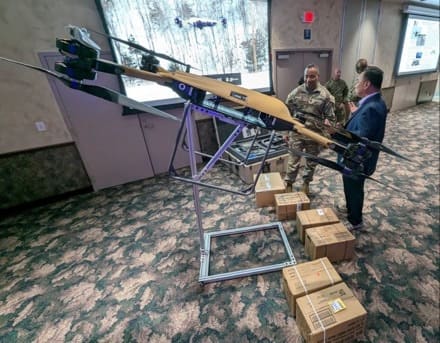
FORT DRUM, N.Y. — The 10th Mountain Division Sustainment Brigade hosted the Innovative Technology Symposium on April 15, 2024 to discuss how the Army is augmenting warfighting capabilities with emerging technologies.
“The intent of this symposium is essentially for us to bring in some of the new technology to Fort Drum and highlight how we can work with different agency partners to get this into the hands of our Soldiers,” said Chief Warrant Officer 2 Edilma Cruz, 10th Mountain Division Sustainment Bridge strategic mobility officer.
Representatives from U.S. Army Combat Capabilities Development Command’s Army Research Lab and the Civil-Military Innovation Institute briefed attendees on technological developments through the Pathfinder and Accelerating FORCE programs.
“The Pathfinder program’s primary mission is to collect whole problem sets from Soldiers at the tactical level,” said Cody Clevenger, Pathfinder program manager. “And we either pair them with academia — from one of our partner schools we work with — if that level of research is needed to execute a solution, or the other way is with our DIRT labs.”
Clevenger briefed three Design, Innovation, Research and Technology, or DIRT, projects funded by the Army Research Lab, including an updated design for the M-80TR anti-personnel landmine used for training.
He said a 2nd Brigade Combat Team Soldier contributed feedback on the assistant gunner bag and the limited options for attaching it to the rucksack. From this, a prototype was developed to improve operational functionality and optimize weight distribution.
“We want to have Soldiers involved throughout the development of a solution,” Clevenger said. “Soldiers love to talk about the problems they have in the field, and we’re trying to give them an avenue where they can do that directly with us.”
The 10th Mountain Division will have their own problem-solving capabilities when the Mountain Innovation Systems Integration Lab becomes operational at Fort Drum by late summer.
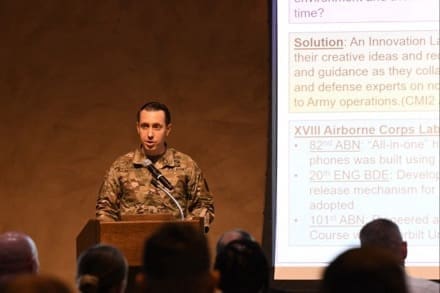
Maj. Michael Fitzgerald, 10th Mountain Division (LI) G-3 knowledge management officer, said the innovation lab is a facility where any Soldier can bring creative ideas to solve problems they encounter through training or on deployments, and they will receive engineering support and guidance.
“Soldiers will have access to equipment such as laser cutters and 3D printers, all at no cost to them because the lab is funded and manned by the Civil-Military Innovation Institute,” he said. “Our partnership with CMI2 will allow us to receive engineering support and collaboration with outside agencies for technologies.”
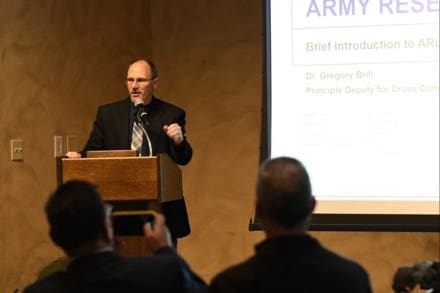
Fitzgerald said an initial focus will be on projects to further the division’s alpine planning efforts.
“But the sky’s the limit on what problems we can solve, and we encourage everyone here to spread the word on what a great opportunity and resource this will be for Soldiers,” he said.
Recently, 10th Mountain Division Soldiers trained on the TRV-150 Tactical Resupply Vehicle and field-tested the drone during the Mountain Peak exercise on post.
The TRV-150 can travel up to 60 miles per hour and can transport up to 150 pounds of cargo, moving in areas that may be inaccessible or too dangerous for vehicles or personnel to conduct resupply missions.
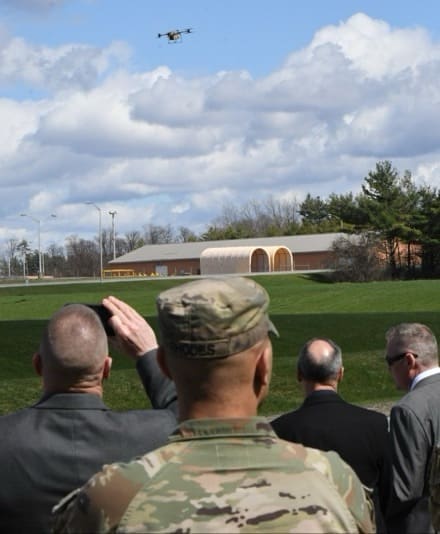
First Lt. Robert Willet, support operations transportation officer with 10th Brigade Support Battalion, 1st Brigade Combat Team, provided feedback as one of the TRV-150 operators. He said seven resupply missions were conducted over four days and they experimented with different payloads to test the drone’s capabilities.
“When used correctly, it’s the fastest method of resupply inside of its radius,” Willet said. “It also had the lowest threat to Soldiers than any other resupply method.”
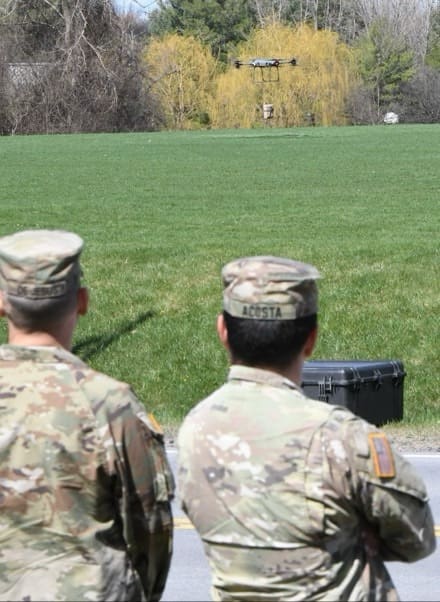
Willet also noted they experienced high-wind conditions that prevented them from flying one day.
“The TRV-150 is close to getting into Soldiers’ hands, but there is additional experimentation that DEVCOM is making to meet the Army’s intent,” Cruz said.
A Civil-Military Innovation Institute team will further examine the TRV-150 in action when 1st Brigade Combat Team conducts a Joint Readiness Training Center rotation at Fort Johnson, Louisiana, in May.
“They will be there the whole time collecting data,” said Dennis Day, Army Research Lab’s Accelerating FORCE deputy program manager. ‘And it’s not just system data, but [tactics, techniques and procedures] and [concepts of operations] that go beyond the ones and zeroes.”
Day said experimenting with emerging technologies in realistic training environments helps to identify problems and improves the final product.
“What we can do is provide a capability,” he said. “But if the Soldier is experimenting with it, providing us feedback, then we can enhance it and get the best product to the Soldier as fast as possible.”
By Mike Strasser, Fort Drum Garrison Public Affairs

SAN DIEGO – 24 April 2024 – General Atomics Aeronautical Systems, Inc. (GA-ASI) has been selected to build production representative flight test articles of the Collaborative Combat Aircraft (CCA) for the U.S. Air Force Life Cycle Management Center’s (AFLCMC) Advanced Aircraft Division. This option contract award by the Advanced Aircraft Division exercises the critical design, build, and flight test on the existing CCA contract with GA-ASI following an initial 6-month phase that culminated in a successful CCA preliminary design review (PDR) earlier this year.
The CCA program aims to be a force multiplier, developing a low-cost, modular, unmanned aircraft equipped with advanced sensors or weapons and operating in collaborative teams with the next generation of manned combat aircraft.
In February 2024, GA-ASI successfully conducted the maiden flight of the XQ-67A CCA protype aircraft validating the “genus/species” concept pioneered by the Air Force Research Laboratory (AFRL) as part of the Low-Cost Attritable Aircraft Platform Sharing (LCAAPS)program. This program focused on building several aircraft variants from a common core chassis. Since then, this prototype for CCA has successfully completed two additional test flights, laying the groundwork for a successful production and flight test program. GA-ASI’s CCA production representative design is based upon the XQ-67A Off-Board Sensing Station developed by GA-ASI for the AFRL.
“The CCA program redefines the future of aviation and will shape the USAF acquisition model to deliver affordable combat mass to the warfighter at the speed of relevancy,” said Mike Atwood, Vice President of Advanced Programs for GA-ASI.
“Throughout our 30-year history, GA-ASI has been at the forefront of rapidly advancing unmanned aircraft systems that support our warfighters,” said GA-ASI President David R. Alexander. “The USAF is moving forward with GA-ASI due to our focused commitment to unmanned air-to-air combat operations and unmatched UAS experience, ensuring the production of the CCA aircraft at scale to deliver affordable combat mass for the warfighter.”
To complement the CCA contract, GA-ASI will continue to conduct a series of autonomy and mission system tests on the MQ-20 Avenger® UAS and XQ-67A to accelerate the readiness of operational autonomy. These live flight tests will continue to demonstrate the readiness of the full mission capability to support the emerging U.S. Air Force Autonomous Collaborative Platforms (ACP).
Ventura, Ca./ 23 April 2024 – Mayman Aerospace will unveil a full-scale model of Razor, its high-speed Air Utility Vehicle, during SOF Week 2024, May 6-10 in Tampa, Florida.
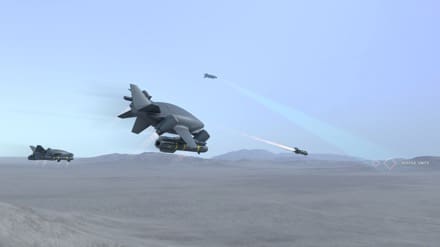
Razor is the name for the military variant of the dual-use, jet-powered, high-speed vertical take-off and landing (HS-VTOL) vehicle, from US-based manufacturer Mayman Aerospace. Derived from the Speeder design, the scalable Razor aircraft will be sized for payloads up to 1,000lb. Prototypes are already under construction for flight test in Q3 this year. The 100lb-payload Razor P100 is expected to fly first, and the 500lb-payload Razor P500 soon after. Mayman Aerospace will showcase a full-scale Razor P100 model during SOF Week 2024.
With more than US$120 million in LOI commitments from customers in Europe and Australia, plus US$3.25 million in US Department of Defense funding, Mayman Aerospace has been expanding its experienced engineering team while ramping up for flight testing.
Mayman Aerospace has also announced development of SkyField™, an AI-driven, autonomous Razor operating environment engineered for seamless integration into existing third-party battlefield management systems. SkyField will enable immediate, effective Razor operations alongside existing hardware and software systems, plus a simplified route to future capability development.
“We are excited to further define and develop Razor and the SkyField operating system as we work to bring the aircraft’s extensive capabilities to the warfighter. Razor is just the first step in creating the SkyField flight mesh. Alongside our Department of Defense colleagues, we are realizing the full capability unlocked by Razor’s unique design in combat scenarios, humanitarian and disaster relief operations, and training,” says David Mayman, CEO and founder of Mayman Aerospace.
Razor fulfills disparate missions in an era where real-world battlefield requirements are rapidly evolving. The need for combat mass through multiple, highly capable, low-cost, and attritable platforms is rapidly emerging. Razor’s low cost, jet speed, and VTOL versatility make it uniquely suitable for the next-generation battlespace.
Easily transported for mass launch in the field, from ships, or the air, Razor may be configured for contested logistics, armed with Hellfire or Brimstone missiles as a range extender for precision attack, flown as a low-cost cruise missile, or equipped with advanced sensors for ISTAR, electronic warfare, and the suppression of enemy air defenses (SEAD). The aircraft will also be used as a high-speed, low-cost target drone, requiring no special launch infrastructure for air-to-air and air defense training.
Mayman Aerospace will be in the BlackHays Group booth #4802 in the JW Marriott Hotel Small Business Conference Room

Over the next few weeks, TRX Systems will be exhibiting our next-generation assured PNT solutions to warfighters at the Modern Day Marine exposition in Washington, DC (Booth 1447) and the SOF Week conference in Tampa, FL (Booth 1944).

April 30 – May 2 /// Washington, D.C. /// Booth 1447
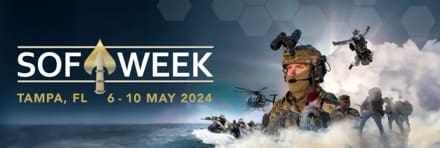
May 6 – 10 /// Tampa, FL ///Booth
Come meet the TRX team at either event to learn about TRX DAPS II, a small, lightweight PNT device that allows dismounted soldiers to better target, maneuver, and communicate, even in environments where GPS is compromised or denied. TRX DAPS II is designed to replace the DAGR and is equipped with standard interfaces, enabling it to plug-and-play with deployed combat systems.
If you’d like to schedule a meeting with our team at either of these upcoming events, please contact us at info@trxsystems.com.
TRX Systems | www.trxsystems.com
London, 25th April 2024 – D3O, world leaders in impact protection solutions, has joined forces with Zotefoams plc, pioneers in cellular materials and lightweight crosslinked foams, to develop a revolutionary new line of ultra-lightweight shock absorbing protective solutions engineered to significantly reduce trauma and back face deformation from blunt impacts and ballistic threats.
This exclusive collaboration between the two companies will introduce a new ballistic material that will be distributed by D3O which can be integrated into body armour systems for defence and law enforcement organizations worldwide.
D3O’s commitment to saving lives is at the forefront of this partnership, aiming to revolutionize protective gear for those operating in high-risk environments. Leveraging the expertise of both companies in energy-absorbing foam development, this venture promises unparalleled protection for individuals facing the most dangerous conditions.
The newly developed D3O Ballistic foam – offered in a range of densities – combines D3O’s expertise in impact mitigation and insight into ballistic end-user needs with Zotefoams’ pioneering cellular materials technology, resulting in a product that sets a new standard in ballistic protection. With industry leading impact protection, along with excellent temperature performance and moisture resistance, D3O Ballistic sets a new standard in ballistic protection.
“This partnership enables us to take another step forward in our ongoing vision to save lives through innovative protective solutions,” said Stuart Sawyer, CEO at D3O. “By combining our strengths with the unique capabilities of Zotefoams and their unique technologies, we are introducing a new era of ultra-lightweight, environment-stable ballistic protection that redefines industry standards.”
David Stirling, Group CEO, Zotefoams added, “We are delighted to announce our partnership with D3O, who will harness the exceptional performance benefits of Zotefoams’ high-performance material to revolutionise personal protection for those working in defence and law enforcement. This partnership perfectly aligns with our purpose of creating optimal material solutions for the benefit of society”.
The newly developed D3O Ballistic material grades will be available exclusively through D3O’s distribution channels and will be featured in the company’s latest generation of ballistic head and body armour solutions.